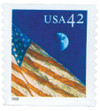
# 4237 - 2008 42c Flags 24/7: Flag at Night s/a
American Flag 24/7
Flag at Night
Die Cut 11, Square Corners
Issue Date: April 18, 2008
City: Washington, DC
Established by Congress in 1942, the American Flag Code is a series of rules concerning the treatment of one of our nation’s most revered and respected symbols. The code states that out of respect for the flag, it should be taken down at night or in times of inclement weather, unless it can be properly lit. Ideally, the flag should be lit with its own bright light, but it is most important that if flown at night, it can be seen clearly.
The principle belief stressed in the Flag Code is that the flag be treated with respect and dignity, and all attempts are made to keep it from being harmed in any way. In the event that the flag is damaged or irreparable, it should be disposed of in a dignified manner (usually by burning).
By order of the President, acts of Congress, and custom, there are a number of places where the American flag should be flown year-round. These places include the White House and the Washington Monument. Also, replicas of the Star Spangled Banner are flown at the Fort McHenry National Monument and Flag House Square, both in Baltimore, Maryland.
The Red, White, and Blue, a patriotic banner representing the American dreams of liberty and freedom, was honored on a set of 2008 U.S. postage stamps showing the flag at different times of day.
American Flag 24/7
Flag at Night
Die Cut 11, Square Corners
Issue Date: April 18, 2008
City: Washington, DC
Established by Congress in 1942, the American Flag Code is a series of rules concerning the treatment of one of our nation’s most revered and respected symbols. The code states that out of respect for the flag, it should be taken down at night or in times of inclement weather, unless it can be properly lit. Ideally, the flag should be lit with its own bright light, but it is most important that if flown at night, it can be seen clearly.
The principle belief stressed in the Flag Code is that the flag be treated with respect and dignity, and all attempts are made to keep it from being harmed in any way. In the event that the flag is damaged or irreparable, it should be disposed of in a dignified manner (usually by burning).
By order of the President, acts of Congress, and custom, there are a number of places where the American flag should be flown year-round. These places include the White House and the Washington Monument. Also, replicas of the Star Spangled Banner are flown at the Fort McHenry National Monument and Flag House Square, both in Baltimore, Maryland.
The Red, White, and Blue, a patriotic banner representing the American dreams of liberty and freedom, was honored on a set of 2008 U.S. postage stamps showing the flag at different times of day.









